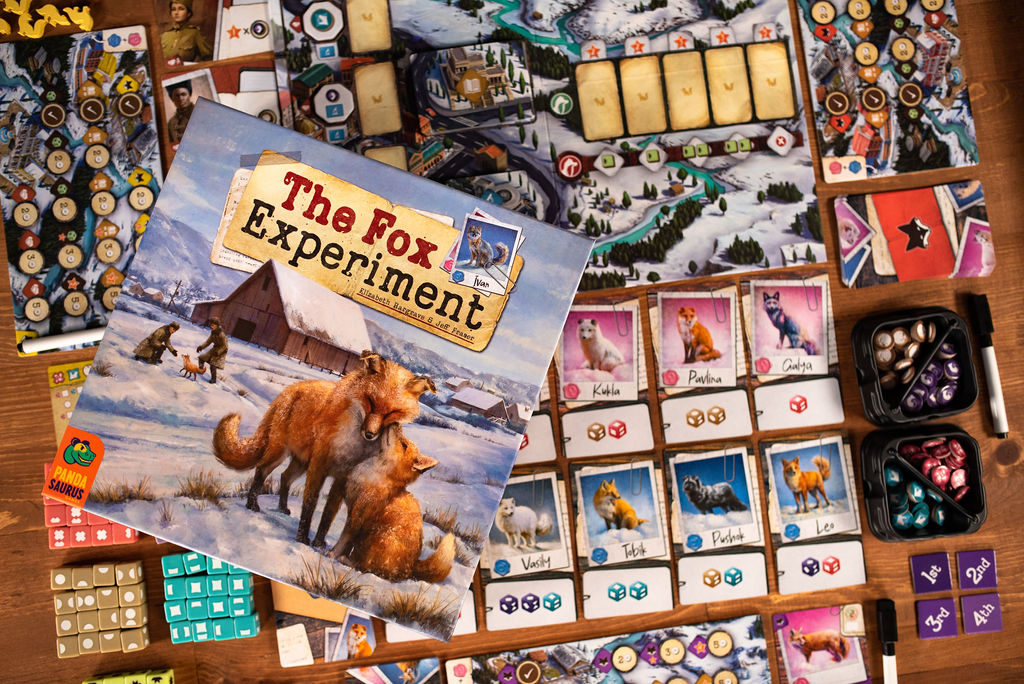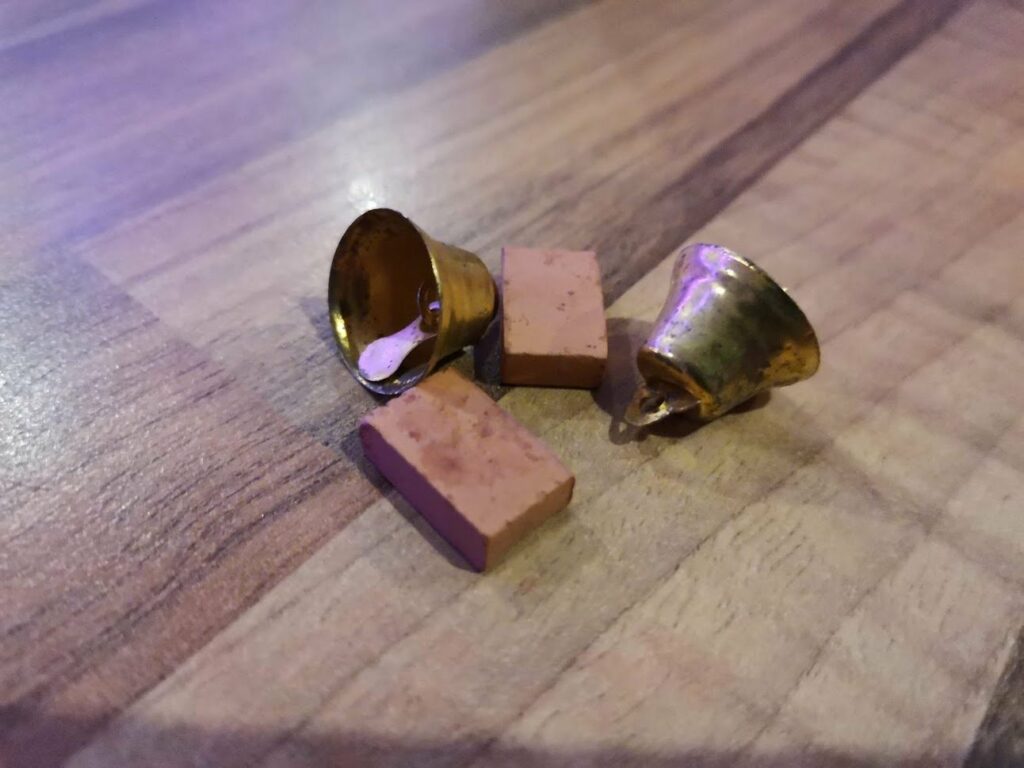Each turn, you'll each choose two foxes - a mummy and a daddy - to have a special cuddle which will result in a baby fox. Ask your parents. The post The Fox Experiment Review appeared first on Punchboard.
Elizabeth Hargrave has the unenviable position of having a hit game to her name. While Wingspan (review here) was and continues to be, a massive hit, its success means that there�s a weight of expectation around her neck. Will each new game be �as good as Wingspan�, or �a Wingspan killer�? It�s probably a bit early to tell with The Fox Experiment, but what I can tell you is that it�s a very good game, full of charm and some interesting mechanisms. Will it fit your group? Read on and find out.
From Russia with love
Or more accurately, from the Soviet Union as it was back then. In the 1950s a couple of scientists decided to start an experiment to see if they could successfully recreate the process of the domestication of dogs. They took a group of Silver Foxes and selected those with the �friendliest� traits to breed over successive generations, to see if what had happened over thousands of years in the past, could happen again.
When I heard about the theme of The Fox Experiment, it sent a small shudder down my spine. I had initial worries about the ethics. Reading up on the subject though, it seems like my original concerns were unfounded. Not only were the foxes not subjected to cruelty (as far as anyone can tell), but the experiment formed part of a rebellion. The Soviet Union officially rejected the current understanding of genetics and instead promoted the work of Trofim Lysenko.
You came here for a game review, not a history lesson, I know, but bear with me. Lysenko�s work was based on pseudoscience, and the rejection of Mendelian genetics (he didn�t believe that genes existed!) lead to thousands of scientists who refused to abandon their views to become destitute, imprisoned, or even killed. The same Trofim Lysenko was later responsible for the practices in the Soviet Union which led to famines not only in his home nation but also in China where his practices were adopted. Read up on him, it�s enlightening to say the least.
So if you coming at this with a preconception of �crazy Russian scientists doing weird, inhumane experiments�, think again. The work of Dmitri Belyaev and Lyudmila Trut (the aforementioned scientists) was important and put them at great personal risk. This game pays homage to the work they did, and it does it without throwing a history book at you.
A chip off the old block
Gameplay in The Fox Experiment seems more complicated than it is in reality. Each turn, you�ll each choose two foxes � a mummy and a daddy � to have a special cuddle which will result in a baby fox. Ask your parents. Each fox card has trait dice associated with them, which you collect and then roll in order to create your babies. The way the dice work is fun. Some faces have a whole symbol, some half a symbol, and some one-and-a-half. Once rolled, you line the dice up and place halves next to one another to create whole symbols.
 The custom trait dice.
The custom trait dice.
Each symbol you create lets you take one of your dry-wipe markers � that�s right kids, this is part roll-and-write! � and colour in the dots and boxes on your next pup card. Perhaps the most adorable thing in the entire game is that each pup card has a space for you to give it a name! I�m not very creative when it comes to naming pups, so my games have had plenty of Steves, Fionas, and Ians. The pups you create go to the kennel (i.e. selection pool) for the next round of the game, hence carrying forward the most prominent genes for successive generations.
This game makes me feel unreasonably sad when my pups aren�t chosen in the following round. They just go to the discard pile. Poor little Susan fox. I have to think of the discard pile like it�s someone�s home, and they�ve just adopted a new, potentially dangerous pet.
�Look, papa, bitey Susan has crapped in your slippers again�
 The turn order track is more important than it seems at first.
The turn order track is more important than it seems at first.
It�s a really clever way of baking the genetics of the subject matter into the genetics of the game. Selectively breeding foxes actually passes the chosen traits on to the next generation, which in turn gives more dice for each trait, increasing the chances of that trait getting stronger again in the following generation. It�s such a simple idea that it makes me wonder why a) it�s not been used more often, or b) why I�ve missed the games where it has been used.
Complex strands of DNA
The Fox Experiment is an easy game to teach, but there�s still plenty of game bubbling away under the surface for those who like their games with a little more bite. For instance, each player has a player board full of potential upgrades. Unlocking upgrades comes at the cost of spending trait tokens, which you get from filling in more dots on the pup cards, as well as certain actions during the game. These upgrades give you things like more friendly (read: wild) dice to roll each turn, or most interestingly to birth more pups each round. Pups make prizes!
 You can keep your Irena and Nikolai, Sharon and Keith are in the kennels now.
You can keep your Irena and Nikolai, Sharon and Keith are in the kennels now.
It�s not a case of blindly picking traits and going with them, either. You each start with a study card too, which rewards you for managing to generate certain numbers of different traits each turn. Another unlockable on your player board grants you more study cards, offering more opportunities to score more points. Then there are the randomly selected patrons for each game which can reward you for accomplishing various things in the game, but only if (you guessed it) you unlock the ability on your player board.
Add to that science cards which offer you bonuses at specific points during the game, and the clever turn order selection which can give you some nice bonuses, but at the expense of having later picks at the kennel in the next round. There�s plenty here to keep your brain busy if fawning over the cute little foxes doesn�t do it for you. Don�t be put off just because appearances make it look lighter than it actually is.
Final thoughts
I only really have a couple of issues with The Fox Experiment, which is pretty high praise. Firstly is my odd emotional connection with the foxes I�ve bred and named, only to watch them immediately disappear into obscurity. I�m just too darn touchy-feely. The other problem for me is the artwork. The symbology is great, very easy to understand throughout, but the saturation and variety of colours in the game makes it hard to pick things out at a glance. It makes the table look really busy. I think that might be a �me� problem rather than a design issue, but who knows?
 There�s a lot of colour. Is it just me?
There�s a lot of colour. Is it just me?
Another thing to bear in mind is whether you intend to buy the game primarily for two players. When you play with any number fewer than three players, you need to run an AI opponent. All it really does is help to take cards out of the market and steal turn order spots, and it�s not difficult to do, but it is just another thing to do on top of playing your own game. With three and four players I think The Fox Experiment is at its best. You only have three actions to take in the first stage of the game (take a fox card twice and claim a turn order space), but agonising over which thing to leave on the table when you know others may want it is great.
The components are great, from the colourful custom dice down to the oh-so-cute fox meeples, and I really like the big tarot-size cards. I think using the dry-wipe pens and cards was a really clever move. The designers could easily have just stacked dice on the cards to go in the kennel display, but people love to draw on cards, and come up with names for their pups. It gets you personally involved with your foxes� lineage. The Fox Experiment is a great middle-weight game with a decent amount of indirect interaction, a solid theme which is really well integrated, and quick, snappy gameplay.
Review copy kindly provided by Pandasaurus Games. Thoughts and opinions are my own.
If you enjoyed this review and would like to read more like this, consider supporting the site by joining my supporters� membership at either Patreon or Ko-fi. It starts from �1 per month, offers member benefits, and lets me know you�re enjoying what I�m doing.

The Fox Experiment (2023)
Design: Elizabeth Hargrave, Jeff Fraser
Publisher: Pandasaurus Games
Art: Joe Shawcross
Players: 1-4
Playing time: 60 mins
The post The Fox Experiment Review appeared first on Punchboard.










